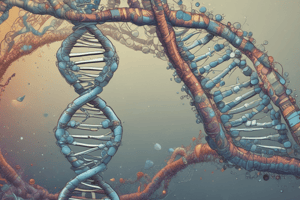Podcast
Questions and Answers
What is the diploid number of chromosomes in humans?
What is the diploid number of chromosomes in humans?
- 13
- 92
- 23
- 46 (correct)
Which of the following statements about genes is true?
Which of the following statements about genes is true?
- A gene is a unit of inheritance that encodes a single protein. (correct)
- Genes can only be found in animal cells.
- Genes vary significantly across all species.
- Genes are exclusively responsible for DNA replication.
What best describes the central dogma of molecular biology?
What best describes the central dogma of molecular biology?
- DNA is transcribed into RNA, which is then translated into proteins. (correct)
- DNA is translated directly to RNA.
- Proteins are converted back into DNA.
- RNA is transcribed into proteins.
What are chromosomes primarily responsible for?
What are chromosomes primarily responsible for?
What is a common function of proteins produced by genes?
What is a common function of proteins produced by genes?
What is one primary characteristic of DNA that makes it suitable for genetic inheritance?
What is one primary characteristic of DNA that makes it suitable for genetic inheritance?
Why is it important to study genetic differences among individuals and ethnicities?
Why is it important to study genetic differences among individuals and ethnicities?
Which statement best describes the role of genomics in health risk assessment?
Which statement best describes the role of genomics in health risk assessment?
What is a key advantage of life science technology in relation to genetic information?
What is a key advantage of life science technology in relation to genetic information?
What is one way in which life science technology can impact human society?
What is one way in which life science technology can impact human society?
Study Notes
Learning Outcomes
- Genomics and related technologies help assess health risks.
- Evaluating the advantages and concerns of life sciences technology and genome information is essential.
- Life science technology significantly impacts human society.
- Understanding genetic differences between individuals and ethnicities is crucial for better personal and societal insights.
DNA Structure
- DNA (Deoxyribonucleic acid) has a double helix structure as discovered by Rosalind Franklin.
- DNA is inheritable, replicable, and stable with a complementary base pairing mechanism.
- Contains four types of nucleotides that store genetic information; chromosomes exist in pairs – one from each parent.
- Human genome comprises two sets of chromosomes (2n=46).
Central Dogma
- Genes are nucleotide sequences encoding proteins or RNA, functioning to maintain life.
- Genes serve as the basic units of inheritance and their sequences are conserved across species.
Genome Sequencing Projects
- Diverse government genomic projects include:
- UK: Genome England
- USA: All of Us Research Program
- China: China Kadoorie Biobank
- Iceland: DeCode Genetics
- Japan: Tohoku Medical MegaBank
- Qatar: Qatar Genome
- Singapore: PRECISE
- Saudi Arabia: Saudi Human Genome Program
- Industry-driven projects focus on precision medicine, disease diagnosis, genetic testing, and understanding human longevity.
Genetic Difference and Diversity
- Genetic variants create differences among individuals; an average of 3-4 million SNPs exist between individual pairs.
- Population admixture leads to a mosaic ancestry structure, influencing genetic diversity across different groups.
- Significant genetic diversity noted across various Asian populations.
Missing Diversity in Genetic Studies
- Major human genetic studies lack representation from diverse populations, particularly Asians.
- Ancestry proportions and representation in genome databases highlight gaps in diversity.
Impact of Ancestry on Genetics
- Ancestry influences the function of genetic variants, with varying risks for conditions like glaucoma based on ethnic backgrounds.
- Different populations exhibit distinct risk levels for genetic-related health issues reflecting demographic history.
Microbiomes and Metagenomics
- Microbes coexist in terrestrial, aquatic, and aerial environments, with vast numbers of microbial cells present in various ecosystems.
- Metagenomics helps unravel microbial communities and their environmental interactions.
- Environmental DNA aids in species identification, biodiversity monitoring, and conservation efforts.
One Health Concept
- One Health emphasizes the interconnectedness of human, animal, and environmental health.
- Genomics plays a key role in enhancing public health care through interdisciplinary collaboration and data sharing.
Genetic Variations and Mutations
- DNA replication errors can lead to mutations, altering DNA sequences and potentially impacting health and development.
Studying That Suits You
Use AI to generate personalized quizzes and flashcards to suit your learning preferences.
Related Documents
Description
This quiz explores the applications of genomics and life science technologies in assessing health risks. It evaluates the advantages and ethical concerns surrounding genome information development and its societal impacts. Additionally, it highlights the importance of studying genetic differences among individuals and ethnicities.




